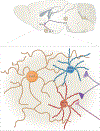Optogenetic investigation of neural circuits underlying brain disease in animal models
- PMID: 22430017
- PMCID: PMC6682316
- DOI: 10.1038/nrn3171
Optogenetic investigation of neural circuits underlying brain disease in animal models
Abstract
Optogenetic tools have provided a new way to establish causal relationships between brain activity and behaviour in health and disease. Although no animal model captures human disease precisely, behaviours that recapitulate disease symptoms may be elicited and modulated by optogenetic methods, including behaviours that are relevant to anxiety, fear, depression, addiction, autism and parkinsonism. The rapid proliferation of optogenetic reagents together with the swift advancement of strategies for implementation has created new opportunities for causal and precise dissection of the circuits underlying brain diseases in animal models.
Conflict of interest statement
Competing interests statement
The authors declare no competing financial interests.
Figures





References
-
- Airan RD, Thompson KR, Fenno LE, Bernstein H & Deisseroth K Temporally precise in vivo control of intracellular signalling. Nature 458, 1025–1029 (2009). - PubMed
-
This study developed the OptoXRs (photosensitive G protein-coupled receptors based on vertebrate opsin genes) for mammalian in vivo use and showed that light-activated intracellular signalling cascades could support conditioned place preference.
-
- Boyden ES, Zhang F, Bamberg E, Nagel G & Deisseroth K Millisecond-timescale, genetically targeted optical control of neural activity. Nature Neurosci. 8, 1263–1268 (2005). - PubMed
-
The initial demonstration of single-component optogenetics using a microbial opsin gene (in this case, a channelrhodopsin).
Publication types
MeSH terms
Grants and funding
LinkOut - more resources
Full Text Sources
Other Literature Sources
Medical

